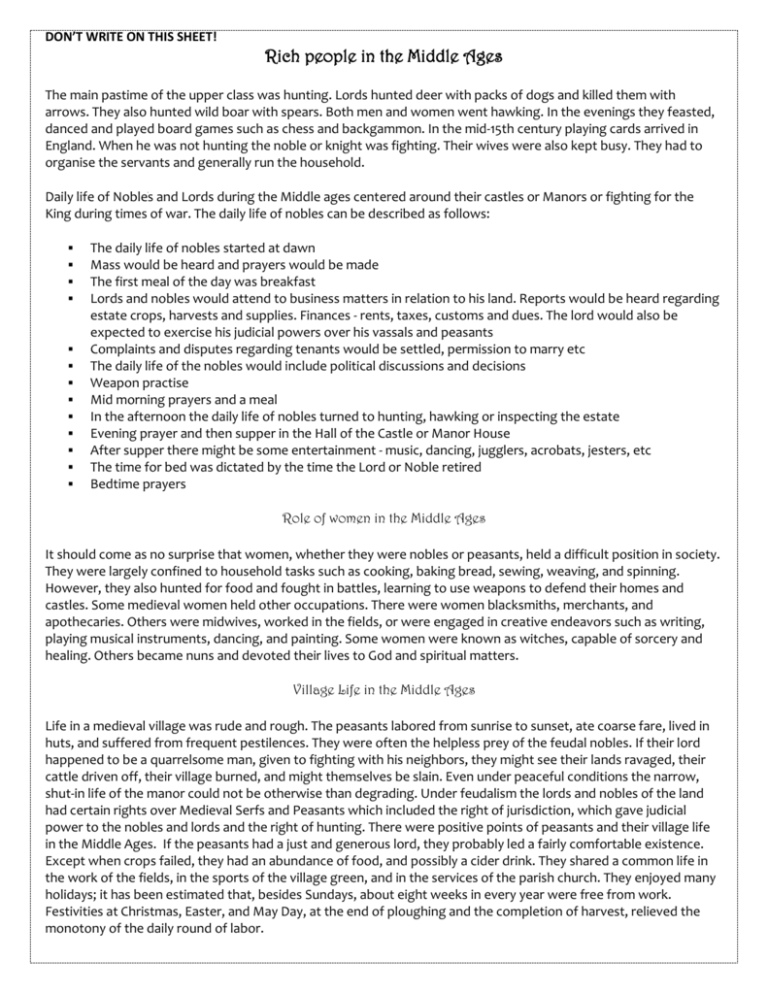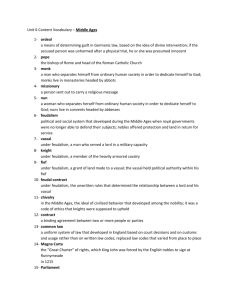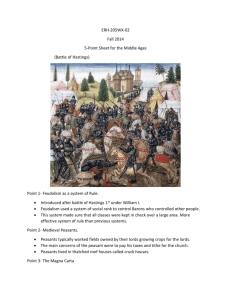A Peasant`s life in the Middle Ages
advertisement

DON’T WRITE ON THIS SHEET! Rich people in the Middle Ages The main pastime of the upper class was hunting. Lords hunted deer with packs of dogs and killed them with arrows. They also hunted wild boar with spears. Both men and women went hawking. In the evenings they feasted, danced and played board games such as chess and backgammon. In the mid-15th century playing cards arrived in England. When he was not hunting the noble or knight was fighting. Their wives were also kept busy. They had to organise the servants and generally run the household. Daily life of Nobles and Lords during the Middle ages centered around their castles or Manors or fighting for the King during times of war. The daily life of nobles can be described as follows: The daily life of nobles started at dawn Mass would be heard and prayers would be made The first meal of the day was breakfast Lords and nobles would attend to business matters in relation to his land. Reports would be heard regarding estate crops, harvests and supplies. Finances - rents, taxes, customs and dues. The lord would also be expected to exercise his judicial powers over his vassals and peasants Complaints and disputes regarding tenants would be settled, permission to marry etc The daily life of the nobles would include political discussions and decisions Weapon practise Mid morning prayers and a meal In the afternoon the daily life of nobles turned to hunting, hawking or inspecting the estate Evening prayer and then supper in the Hall of the Castle or Manor House After supper there might be some entertainment - music, dancing, jugglers, acrobats, jesters, etc The time for bed was dictated by the time the Lord or Noble retired Bedtime prayers Role of women in the Middle Ages It should come as no surprise that women, whether they were nobles or peasants, held a difficult position in society. They were largely confined to household tasks such as cooking, baking bread, sewing, weaving, and spinning. However, they also hunted for food and fought in battles, learning to use weapons to defend their homes and castles. Some medieval women held other occupations. There were women blacksmiths, merchants, and apothecaries. Others were midwives, worked in the fields, or were engaged in creative endeavors such as writing, playing musical instruments, dancing, and painting. Some women were known as witches, capable of sorcery and healing. Others became nuns and devoted their lives to God and spiritual matters. Village Life in the Middle Ages Life in a medieval village was rude and rough. The peasants labored from sunrise to sunset, ate coarse fare, lived in huts, and suffered from frequent pestilences. They were often the helpless prey of the feudal nobles. If their lord happened to be a quarrelsome man, given to fighting with his neighbors, they might see their lands ravaged, their cattle driven off, their village burned, and might themselves be slain. Even under peaceful conditions the narrow, shut-in life of the manor could not be otherwise than degrading. Under feudalism the lords and nobles of the land had certain rights over Medieval Serfs and Peasants which included the right of jurisdiction, which gave judicial power to the nobles and lords and the right of hunting. There were positive points of peasants and their village life in the Middle Ages. If the peasants had a just and generous lord, they probably led a fairly comfortable existence. Except when crops failed, they had an abundance of food, and possibly a cider drink. They shared a common life in the work of the fields, in the sports of the village green, and in the services of the parish church. They enjoyed many holidays; it has been estimated that, besides Sundays, about eight weeks in every year were free from work. Festivities at Christmas, Easter, and May Day, at the end of ploughing and the completion of harvest, relieved the monotony of the daily round of labor. DON’T WRITE ON THIS SHEET! The Clergy in the Middle Ages A monk is a man who is a member of a brotherhood. He devotes his life to a discipline prescribed by his order. Monks and nuns live in a monastery. A monastery is a kind of half church half hospital. They take care of people there and they pray and meditate. It can also be like a school for kids. They would teach them how to read and write. Monks and nuns spent most of their time praying meditating, and doing tasks like preparing medicine, or sewing,teaching, writing, and reading. Monks and nuns were very busy but also organized. Some of their work was called Cloister. This was taken place in the heart of the monastery. (The monastery was usually in the shape of a cross to remind them of Christ’s death). There was a four sided square which they walked around while studying and writing out prayers and parts of the bible. They published their books by hand. They wrote very neatly and drew pictures too. They decorated the first letter of each paragraph with great care. Sometimes they used gold for writing very fancy. When people became Monks, they made three vows. The first vow was called the vow of poverty. The vow of poverty meant you had to give up all personal possessions. The second vow was a vow to stay single. This vow was called chastity. The third vow was a vow to promise to obey the church and the monastery. This was called the vow of obedience. But after awhile some of the monks and nuns disobeyed some of the vows. This is one of the reasons the Benedict law became low. One other reason was that some monasteries became wealthy. Most people had to go to church like they had to go to school. People even had to pay taxes to churches. Taxes still must be paid to churches in Germany. Monks ate in a place called a refectory. While they ate, there was silence, except for a priest reading parts of the Bible. The tables were long and stretched out across the room. When some monasteries became wealthy, they had very fancy food. A few people led religious lives totally on their own. These people were called hermits. They were thought to be holy and wise. They lived simply in small isolated houses. They often suffered physical hardship. Some hermits, especially women, were walled up in their houses. Some monks and nuns became wealthy, despite making vows of poverty. They joined monasteries because they liked having special privileges. Some parents promised their children to monasteries. They did this because they knew that their children would never be homeless, nor without food. Also, if they were talented, this was a way for them to become rich or successful. Monks and nuns performed many roles in the middle ages. They provided shelter, they taught others to read and write, prepared medicine, sewed clothes for others, and helped others in times of need. They spent most of their time praying and meditating. Originally, they craved the love of God and took vows of poverty, obedience, and chastity. However, as orders became more wealthy and powerful, some people went into orders - for money and power. Most monasteries remained important centers of caring and learning. DON’T WRITE ON THIS SHEET! A Peasant’s life in the Middle Ages For peasants life was one of toil. Most people in the Middle Ages lived in small villages of 20 or 30 families. The land was divided into 3 huge fields. Each year 2 were sown with crops while one was left fallow (unused) to allow it to recover. Each peasant had some strips of land in each field. Most peasants owned only one ox so they had to join with other families to obtain the team of oxen needed to pull a plough. After ploughing the land was sown. Men sowed grain and women planted peas and beans. Most peasants also owned a few cows, goats and sheep. Cows and goats gave milk and cheese. Most peasants also kept chickens for eggs. They also kept pigs. Peasants were allowed to graze their livestock on common land. In the autumn they let their pigs roam in the woods to eat acorns and beechnuts. However they did not have enough food to keep many animals through the winter. Most of the livestock was slaughtered in autumn and the meat was salted to preserve it. However life was not all hard work. People were allowed to rest on Holy days (from which we get our word holiday). During them poor people danced and wrestled. They also played a very rough form of football. The men from 2 villages played on a 'pitch' which might include woods and streams! There were no rules so broken limbs and other injuries were common. People also enjoyed cruel 'sports' like dog fighting and bear baiting. (A bear was chained to a post and dogs were trained to attack it). Gambling was also common. Role of women in the Middle Ages It should come as no surprise that women, whether they were nobles or peasants, held a difficult position in society. They were largely confined to household tasks such as cooking, baking bread, sewing, weaving, and spinning. However, they also hunted for food and fought in battles, learning to use weapons to defend their homes and castles. Some medieval women held other occupations. There were women blacksmiths, merchants, and apothecaries. Others were midwives, worked in the fields, or were engaged in creative endeavors such as writing, playing musical instruments, dancing, and painting. Some women were known as witches, capable of sorcery and healing. Others became nuns and devoted their lives to God and spiritual matters. Village Life in the Middle Ages Life in a medieval village was rude and rough. The peasants labored from sunrise to sunset, ate coarse fare, lived in huts, and suffered from frequent pestilences. They were often the helpless prey of the feudal nobles. If their lord happened to be a quarrelsome man, given to fighting with his neighbors, they might see their lands ravaged, their cattle driven off, their village burned, and might themselves be slain. Even under peaceful conditions the narrow, shut-in life of the manor could not be otherwise than degrading. Under feudalism the lords and nobles of the land had certain rights over Medieval Serfs and Peasants which included the right of jurisdiction, which gave judicial power to the nobles and lords and the right of hunting. There were positive points of peasants and their village life in the Middle Ages. If the peasants had a just and generous lord, they probably led a fairly comfortable existence. Except when crops failed, they had an abundance of food, and possibly a cider drink. They shared a common life in the work of the fields, in the sports of the village green, and in the services of the parish church. They enjoyed many holidays; it has been estimated that, besides Sundays, about eight weeks in every year were free from work. Festivities at Christmas, Easter, and May Day, at the end of ploughing and the completion of harvest, relieved the monotony of the daily round of labor. DON’T WRITE ON THIS SHEET! Life of a Knight Training for knighthood during medieval times usually began at an early age. Often the prospective knight was sent to live with a relative or lord who had the resources to train the young boy in use of weapons and, most importantly, the skills to handle a horse in combat. A knight-in-training would often serve as a squire (assistant) for an established knight, attending his needs, helping him don his armor, and making ready his horse and weapons. Once his training was completed and he reached "fighting age" (usually around 16-20 years old), he would ceremoniously become a full-fledged knight. The ceremony became more elaborate as the Middle Ages progressed, until only the richest nobles or a king could afford to "knight" someone. The new knight now served his liege lord (which may or may not be the king himself), bound to offer military service up to 40 days a year in peace time, more, as needed, in war time. Military duties included castle guard, serving in the lord's "bodyguard", and participating in battle. Apart from military duties the knight could also participate in administering justice (as part of assizes--a medieval form of our modern juries), manage his estates (which was his prime source of income), and continue to hone his combat skills in tournament. The Tournament The tournament in the early Middle Ages (ca. 800-1200 C.E.) was often a meleé, resembling actual combat in groups that could result in injuries or even death. Men were taken hostage and held for ransom, horses and armor confiscated by the captors. As kings and churchmen grew concerned over this senseless loss of life and resources new regulations and safety measures were put into effect. The meleé was replaced by individual combat events (among them the joust), and new innovations in armor specifically designed for the tournament made it somewhat safer. The daily life of a knight in the Middle ages followed a similar schedule to that of his lord or the noble he served. The Daily life of a Knight during the Middle ages centred around castles or Manors or fighting for his lord and the King during times of war. Much of his time was spent on honing his weapons skills and keeping his levels of fitness high. The daily life of knights can be described as follows: The daily life of a Knight started at dawn when Mass would be heard and prayers would be made The first meal of the day for the Knight was breakfast Knights would engage in weapons practise at the quintain and the pell The daily life of the Knights would include discussions on warfare strategy and increasing his knowledge of siege warfare and weapons Mid morning prayers and a meal As the Medieval period progressed the culture changed becoming more refined and elegant. Knights were expected to understand the rules of Chivalry and courtly love. Time might be spent on dance practise In the afternoon the daily life of Knights turned to increasing their skills in horsemanship and would accompany their lord in hunting, hawking or inspecting the estate Evening prayer and then supper in the Hall of the Castle or Manor House After supper there might be some entertainment - music, dancing, jugglers, acrobats, jesters, etc Bedtime prayers






